On Nov. 17, 1667 at New Haven, Conn., Richard m. 1) Elizabeth Tuttle, dau. of William Tuttle and his wife Elizabeth, b. at New Haven where she was bapt. Nov. 9, 1645. After much trial and tribulation, Richard was granted a divorce from Elizabeth in 1691. When and where Elizabeth subsequently died is unknown, with an extended summary at her own memorial. Richard and Elizabeth had six children b. at Hartford and are outlined in their mother's memorial.
In circa 1692 Richard m. 2) at Hartford, Mary Talcott, dau. of Col. John Talcott and Helena Wakeman, b. Apr. 26, 1661 at Hartford where she d. Apr. 19, 1723, Æ 62. They had the following children b. of record at Hartford: Jonathan (d.y.), John, Hannah, Richard (d.y.), Daniel, and Samuel.
The following account, albeit true, was included by the creator of the memorial for Richard's second wife Mary Talcott. But, as Richard Edwards and first wife Elizabeth Tuttle are the writer's ancestors, a more positive presentation would seem appropriate.
• Seventeenth-century Hartford was no stranger to scandal, as the story of Richard Edwards and Mary, his second wife, vividly proves. In 1667 Richard Edwards, 20, married 22-year-old Elizabeth Tuttle of New Haven. During two decades of marriage Elizabeth gave birth to six [sic seven] children. Richard insisted he was not the father of the first-born, which Elizabeth conceived by another man before the marriage to Richard.
• In 1689 Richard, now a prosperous and powerful attorney, petitioned the Connecticut General Court for a divorce on the grounds of insanity and adultery. There is evidence that Richard, too, had committed adultery. The Court denied Richard's request, but he petitioned again in 1691, claiming Elizabeth had threatened "to Cut my throat when I was Asleep." Richard had good reason to take his wife seriously, for her family had a history of homicidal insanity, including a brother who murdered their sister in a deranged fit of anger. This time the Court granted the divorce.
• Within months Richard, 44, wed 27-year-old Mary Talcott, with whom records suggest he had committed adultery. The couple were apparently able to live down the scandal that preceded their marriage, for both were admitted to full communion in the First Congregational Church, and Richard later was appointed Queen's Attorney for Connecticut. Mary bore Richard another half dozen children before his death in 1718.
• No one knows what happened to Elizabeth (Tuttle) Edwards following the divorce. The only son Elizabeth bore Richard, named Timothy, became the father of the Reverend Jonathan Edwards, one of the greatest religious figures in American history." (www.theancientburyingground.org)
In the early 1900s the Eugenics movement in America began to mature with multiple works published extolling the need for social change regarding human reproduction. The movement was underpinned by taking the family and progeny of Richard Edwards' grandson, Rev. Jonathan Edwards of Northampton, Mass., as an example of everything that was good with human reproduction. Conversely, an anonymous family in upstate New York (which turned out to be a fictitious one) was used as an example of that which was wrong with human reproduction leading to those who were mentally incompetent, lawless, and mentally ill. In the 1930s Adolph Hitler of Germany adopted the eugenics movement as a basis for forced sterilization of German women with purported inferior Ayrian race reproductive qualities. Hitler would further corrupt the basis of eugenics as justification for his extermination of Jews during the Holocaust.
As part of the published argument, American eugenics authors extolled the obvious negative mental qualities (called "remarkably positive" by eugenics authors) of Richard's first wife Elizabeth Tuttle contrasted to the "positive" intellectual qualities of the progeny of Elizabeth's grandson Jonathan Edwards, while considering the family of Richard Edward's second family by Mary Talcott as intellectually mediocre:
• "In spite of all the negatives said about her, Elizabeth Tuttle Edwards’ remarkable positive qualities are evidenced by the many brilliant, prominent and influential people descended from Richard Edwards and her. Further weight is given by the fact that none of Mary Talcott's progeny rose above mediocrity and their descendants gained no abiding reputation."
The ancestry of Mary (Talcott) Edwards and her own progeny were persons far from "mediocre with no abiding reputation."
Revised and expanded 1/31/2017 along with second wife Mary Talcott's memorial.
On Nov. 17, 1667 at New Haven, Conn., Richard m. 1) Elizabeth Tuttle, dau. of William Tuttle and his wife Elizabeth, b. at New Haven where she was bapt. Nov. 9, 1645. After much trial and tribulation, Richard was granted a divorce from Elizabeth in 1691. When and where Elizabeth subsequently died is unknown, with an extended summary at her own memorial. Richard and Elizabeth had six children b. at Hartford and are outlined in their mother's memorial.
In circa 1692 Richard m. 2) at Hartford, Mary Talcott, dau. of Col. John Talcott and Helena Wakeman, b. Apr. 26, 1661 at Hartford where she d. Apr. 19, 1723, Æ 62. They had the following children b. of record at Hartford: Jonathan (d.y.), John, Hannah, Richard (d.y.), Daniel, and Samuel.
The following account, albeit true, was included by the creator of the memorial for Richard's second wife Mary Talcott. But, as Richard Edwards and first wife Elizabeth Tuttle are the writer's ancestors, a more positive presentation would seem appropriate.
• Seventeenth-century Hartford was no stranger to scandal, as the story of Richard Edwards and Mary, his second wife, vividly proves. In 1667 Richard Edwards, 20, married 22-year-old Elizabeth Tuttle of New Haven. During two decades of marriage Elizabeth gave birth to six [sic seven] children. Richard insisted he was not the father of the first-born, which Elizabeth conceived by another man before the marriage to Richard.
• In 1689 Richard, now a prosperous and powerful attorney, petitioned the Connecticut General Court for a divorce on the grounds of insanity and adultery. There is evidence that Richard, too, had committed adultery. The Court denied Richard's request, but he petitioned again in 1691, claiming Elizabeth had threatened "to Cut my throat when I was Asleep." Richard had good reason to take his wife seriously, for her family had a history of homicidal insanity, including a brother who murdered their sister in a deranged fit of anger. This time the Court granted the divorce.
• Within months Richard, 44, wed 27-year-old Mary Talcott, with whom records suggest he had committed adultery. The couple were apparently able to live down the scandal that preceded their marriage, for both were admitted to full communion in the First Congregational Church, and Richard later was appointed Queen's Attorney for Connecticut. Mary bore Richard another half dozen children before his death in 1718.
• No one knows what happened to Elizabeth (Tuttle) Edwards following the divorce. The only son Elizabeth bore Richard, named Timothy, became the father of the Reverend Jonathan Edwards, one of the greatest religious figures in American history." (www.theancientburyingground.org)
In the early 1900s the Eugenics movement in America began to mature with multiple works published extolling the need for social change regarding human reproduction. The movement was underpinned by taking the family and progeny of Richard Edwards' grandson, Rev. Jonathan Edwards of Northampton, Mass., as an example of everything that was good with human reproduction. Conversely, an anonymous family in upstate New York (which turned out to be a fictitious one) was used as an example of that which was wrong with human reproduction leading to those who were mentally incompetent, lawless, and mentally ill. In the 1930s Adolph Hitler of Germany adopted the eugenics movement as a basis for forced sterilization of German women with purported inferior Ayrian race reproductive qualities. Hitler would further corrupt the basis of eugenics as justification for his extermination of Jews during the Holocaust.
As part of the published argument, American eugenics authors extolled the obvious negative mental qualities (called "remarkably positive" by eugenics authors) of Richard's first wife Elizabeth Tuttle contrasted to the "positive" intellectual qualities of the progeny of Elizabeth's grandson Jonathan Edwards, while considering the family of Richard Edward's second family by Mary Talcott as intellectually mediocre:
• "In spite of all the negatives said about her, Elizabeth Tuttle Edwards’ remarkable positive qualities are evidenced by the many brilliant, prominent and influential people descended from Richard Edwards and her. Further weight is given by the fact that none of Mary Talcott's progeny rose above mediocrity and their descendants gained no abiding reputation."
The ancestry of Mary (Talcott) Edwards and her own progeny were persons far from "mediocre with no abiding reputation."
Revised and expanded 1/31/2017 along with second wife Mary Talcott's memorial.
Inscription
Here Lies
Interd ye
Body of Mr
Richard Edwa~
rds Who DYed
April 20th ~~
1718 Æ tatis
Sue [sic] 71
On the day Richard died he was 70 years old, and "Ætatis suæ" (i.e., Æ, "Aged," in the XX year of his Age) 71. The Latin phrase Ætatis suae means "In the year of one's age."
Family Members
Advertisement
Explore more
Sponsored by Ancestry
Advertisement











